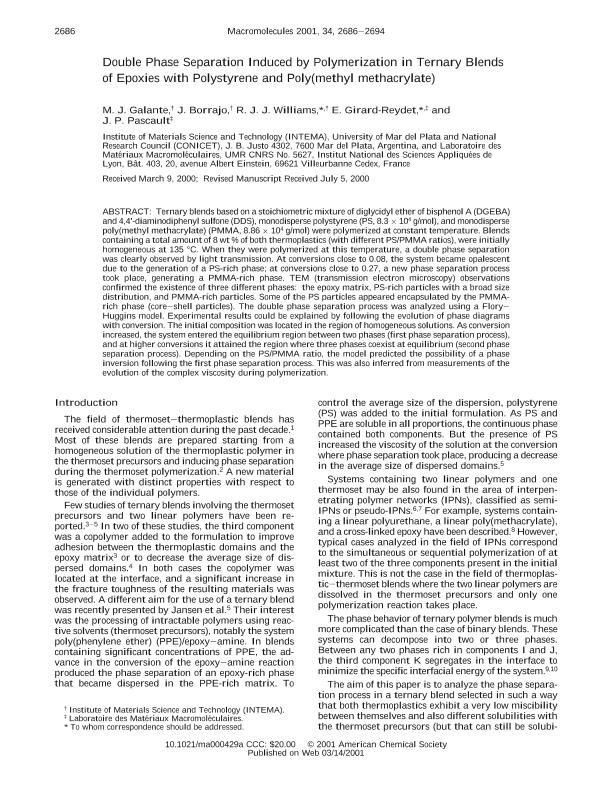Mostrar el registro sencillo del ítem
dc.contributor.author
Galante, Maria Jose

dc.contributor.author
Borrajo Fernandez, Julio

dc.contributor.author
Williams, Roberto Juan Jose

dc.contributor.author
Girardt Reydet, E.
dc.contributor.author
Pascault, J.P.
dc.date.available
2019-05-27T18:28:30Z
dc.date.issued
2001-04
dc.identifier.citation
Galante, Maria Jose; Borrajo Fernandez, Julio; Williams, Roberto Juan Jose; Girardt Reydet, E.; Pascault, J.P.; Double phase separation induced by polymerization in ternary blends of epoxies with polystyrene and poly(methyl methacrylate); American Chemical Society; Macromolecules; 34; 8; 4-2001; 2686-2694
dc.identifier.issn
0024-9297
dc.identifier.uri
http://hdl.handle.net/11336/77243
dc.description.abstract
Ternary blends based on a stoichiometric mixture of diglycidyl ether of bisphenol A (DGEBA) and 4,4'-diaminodiphenyl sulfone (DDS), monodisperse polystyrene (PS, 8.3 × 104 g/mol), and monodisperse poly(methyl methacrylate) (PMMA, 8.86 × 104 g/mol) were polymerized at constant temperature. Blends containing a total amount of 8 wt % of both thermoplastics (with different PS/PMMA ratios), were initially homogeneous at 135 °C. When they were polymerized at this temperature, a double phase separation was clearly observed by light transmission. At conversions close to 0.08, the system became opalescent due to the generation of a PS-rich phase; at conversions close to 0.27, a new phase separation process took place, generating a PMMA-rich phase. TEM (transmission electron microscopy) observations confirmed the existence of three different phases: The epoxy matrix, PS-rich particles with a broad size distribution, and PMMA-rich particles. Some of the PS particles appeared encapsulated by the PMMA-rich phase (core-shell particles). The double phase separation process was analyzed using a Flory-Huggins model. Experimental results could be explained by following the evolution of phase diagrams with conversion. The initial composition was located in the region of homogeneous solutions. As conversion increased, the system entered the equilibrium region between two phases (first phase separation process), and at higher conversions it attained the region where three phases coexist at equilibrium (second phase separation process). Depending on the PS/PMMA ratio, the model predicted the possibility of a phase inversion following the first phase separation process. This was also inferred from measurements of the evolution of the complex viscosity during polymerization.
dc.format
application/pdf
dc.language.iso
eng
dc.publisher
American Chemical Society

dc.rights
info:eu-repo/semantics/openAccess
dc.rights.uri
https://creativecommons.org/licenses/by-nc-sa/2.5/ar/
dc.subject
Phase Separation
dc.subject
Epoxy
dc.subject
Polystyrene
dc.subject
Poly(Methylmethacrylate)
dc.subject.classification
Físico-Química, Ciencia de los Polímeros, Electroquímica

dc.subject.classification
Ciencias Químicas

dc.subject.classification
CIENCIAS NATURALES Y EXACTAS

dc.subject.classification
Ingeniería de los Materiales

dc.subject.classification
Ingeniería de los Materiales

dc.subject.classification
INGENIERÍAS Y TECNOLOGÍAS

dc.title
Double phase separation induced by polymerization in ternary blends of epoxies with polystyrene and poly(methyl methacrylate)
dc.type
info:eu-repo/semantics/article
dc.type
info:ar-repo/semantics/artículo
dc.type
info:eu-repo/semantics/publishedVersion
dc.date.updated
2019-05-15T18:14:46Z
dc.journal.volume
34
dc.journal.number
8
dc.journal.pagination
2686-2694
dc.journal.pais
Estados Unidos

dc.journal.ciudad
Washington
dc.description.fil
Fil: Galante, Maria Jose. Consejo Nacional de Investigaciones Científicas y Técnicas. Centro Científico Tecnológico Conicet - Mar del Plata. Instituto de Investigaciones en Ciencia y Tecnología de Materiales. Universidad Nacional de Mar del Plata. Facultad de Ingeniería. Instituto de Investigaciones en Ciencia y Tecnología de Materiales; Argentina
dc.description.fil
Fil: Borrajo Fernandez, Julio. Consejo Nacional de Investigaciones Científicas y Técnicas. Centro Científico Tecnológico Conicet - Mar del Plata. Instituto de Investigaciones en Ciencia y Tecnología de Materiales. Universidad Nacional de Mar del Plata. Facultad de Ingeniería. Instituto de Investigaciones en Ciencia y Tecnología de Materiales; Argentina
dc.description.fil
Fil: Williams, Roberto Juan Jose. Consejo Nacional de Investigaciones Científicas y Técnicas. Centro Científico Tecnológico Conicet - Mar del Plata. Instituto de Investigaciones en Ciencia y Tecnología de Materiales. Universidad Nacional de Mar del Plata. Facultad de Ingeniería. Instituto de Investigaciones en Ciencia y Tecnología de Materiales; Argentina
dc.description.fil
Fil: Girardt Reydet, E.. Institut National des Sciences Appliquées de Lyon; Francia
dc.description.fil
Fil: Pascault, J.P.. Institut National des Sciences Appliquées de Lyon; Francia
dc.journal.title
Macromolecules

dc.relation.alternativeid
info:eu-repo/semantics/altIdentifier/url/https://pubs.acs.org/doi/abs/10.1021/ma000429a
dc.relation.alternativeid
info:eu-repo/semantics/altIdentifier/doi/http://dx.doi.org/10.1021/ma000429a
Archivos asociados
